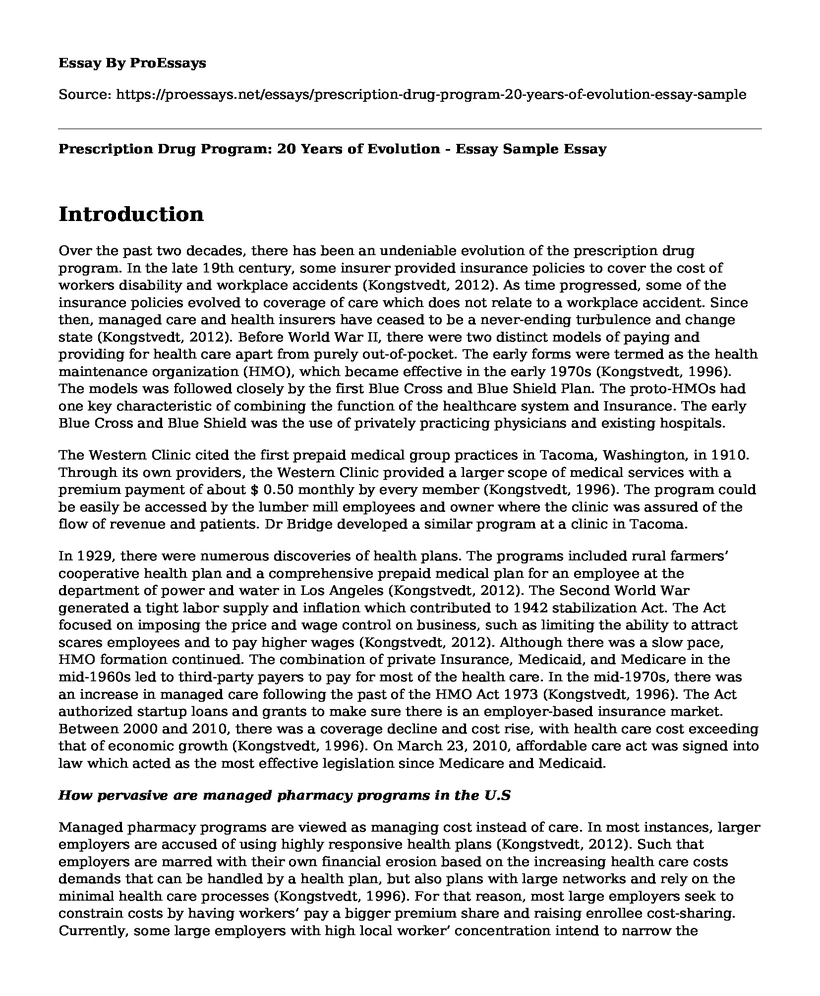Introduction
Over the past two decades, there has been an undeniable evolution of the prescription drug program. In the late 19th century, some insurer provided insurance policies to cover the cost of workers disability and workplace accidents (Kongstvedt, 2012). As time progressed, some of the insurance policies evolved to coverage of care which does not relate to a workplace accident. Since then, managed care and health insurers have ceased to be a never-ending turbulence and change state (Kongstvedt, 2012). Before World War II, there were two distinct models of paying and providing for health care apart from purely out-of-pocket. The early forms were termed as the health maintenance organization (HMO), which became effective in the early 1970s (Kongstvedt, 1996). The models was followed closely by the first Blue Cross and Blue Shield Plan. The proto-HMOs had one key characteristic of combining the function of the healthcare system and Insurance. The early Blue Cross and Blue Shield was the use of privately practicing physicians and existing hospitals.
The Western Clinic cited the first prepaid medical group practices in Tacoma, Washington, in 1910. Through its own providers, the Western Clinic provided a larger scope of medical services with a premium payment of about $ 0.50 monthly by every member (Kongstvedt, 1996). The program could be easily be accessed by the lumber mill employees and owner where the clinic was assured of the flow of revenue and patients. Dr Bridge developed a similar program at a clinic in Tacoma.
In 1929, there were numerous discoveries of health plans. The programs included rural farmers’ cooperative health plan and a comprehensive prepaid medical plan for an employee at the department of power and water in Los Angeles (Kongstvedt, 2012). The Second World War generated a tight labor supply and inflation which contributed to 1942 stabilization Act. The Act focused on imposing the price and wage control on business, such as limiting the ability to attract scares employees and to pay higher wages (Kongstvedt, 2012). Although there was a slow pace, HMO formation continued. The combination of private Insurance, Medicaid, and Medicare in the mid-1960s led to third-party payers to pay for most of the health care. In the mid-1970s, there was an increase in managed care following the past of the HMO Act 1973 (Kongstvedt, 1996). The Act authorized startup loans and grants to make sure there is an employer-based insurance market. Between 2000 and 2010, there was a coverage decline and cost rise, with health care cost exceeding that of economic growth (Kongstvedt, 1996). On March 23, 2010, affordable care act was signed into law which acted as the most effective legislation since Medicare and Medicaid.
How pervasive are managed pharmacy programs in the U.S
Managed pharmacy programs are viewed as managing cost instead of care. In most instances, larger employers are accused of using highly responsive health plans (Kongstvedt, 2012). Such that employers are marred with their own financial erosion based on the increasing health care costs demands that can be handled by a health plan, but also plans with large networks and rely on the minimal health care processes (Kongstvedt, 1996). For that reason, most large employers seek to constrain costs by having workers’ pay a bigger premium share and raising enrollee cost-sharing. Currently, some large employers with high local worker’ concentration intend to narrow the network. However, the managed pharmacy was unable to respond well to the backlash. In other words, it failed to make substantial efforts at self-regulation regardless of the enormous support of the NCQA from most health plans.
References
Kongstvedt, P. R. (1996). Essentials of managed health care. Journal For Healthcare Quality, 18(2), 40. https://doi.org/10.1097/01445442-199603000-00015
Kongstvedt, P. R. (2012). Essentials of managed health care. Jones & Bartlett Publishers.
Cite this page
Prescription Drug Program: 20 Years of Evolution - Essay Sample. (2023, Aug 12). Retrieved from https://proessays.net/essays/prescription-drug-program-20-years-of-evolution-essay-sample
If you are the original author of this essay and no longer wish to have it published on the ProEssays website, please click below to request its removal:
- Breast Cancer in Iran and UK
- Extended Literature Review on Rheumatoid Arthritis: Risks and Benefits of Latest Treatments
- Research Paper Example on Triage Systems in Emergency Departments
- Essay Sample on Terrorism as a Worldwide Threat: HME509 Case 3
- The Pay Gap Between Women and Their Male Counterparts - Research Paper
- Multidimensional Theory of Gender Inequality Essay Example
- Fact Sheet on Health Care Insurance Plans - Paper Example







